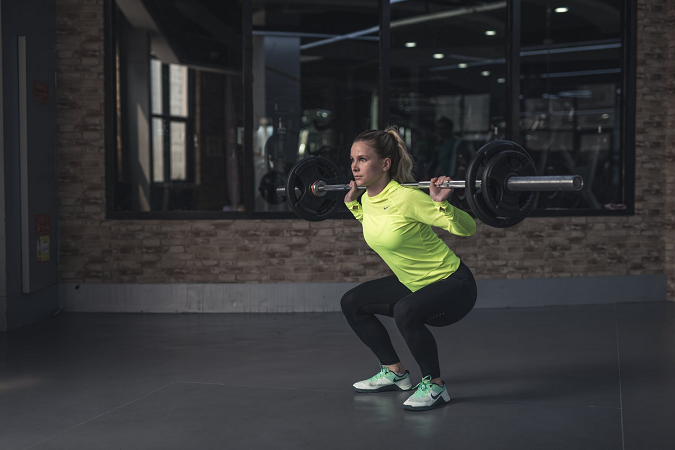Squats should be utilized by athletes to increase strength, endurance, lung power and heart health. Squats are a tremendous anaerobic and aerobic exercise. Squats target a large number of muscle groups and joints. Squats increase strength and endurance in the back, hips and legs.
The squat is a basic multi-joint exercise in which the knees and hips flex while the spine is held upright. It is used by all types of athletes to build strength and increase conditioning. The squat is considered by some as the king of exercises.
Please don’t feel that heavy weights must be used for the squat to be effective. A variety of set and rep schemes along with multiple stances and movement depth accomplish a wide assortment of training objectives. Squatting routines formulated to help you achieve your athletic goals make great training programs.
Anaerobic Fitness: Squats should be the centerpiece exercise in an athlete’s lower body strengthening routine. If your objective is to increase lower body strength then squats should be the first exercise in your training program.
Aerobic Fitness: Squatting is a large motion that requires the heart and lungs to function at an increased capacity. Incorporate squats into your aerobic training to increase cardiovascular and respiratory system health.
Technique: Proper form is essential for safety. I have seen too many trainees injury their lower backs by using poor technique. Work with a certified fitness trainer to learn perfect technique, Practice perfect technique repeatedly. Once your technique is flawless then increase intensity.
Correct Technique: Maintain your back in a straight upright posture throughout the entire exercise. Never lean forward. Look straight ahead to keep your neck aligned with your spine. Do not tilt your head upward or downward. Lower yourself in a slow and control manner. Never bounce at the bottom position. When descending, your pelvis should move backwards as if you are sitting in a chair.
Safety: Technique is much more important than intensity. Squats are an easy exercise to perform incorrectly. Often lifters lean forward and place increased pressure on their spine when straining to complete an intense set. It is my professional opinion that a lifter should never work to one hundred percent of his maximum in barbell squats. The risk is too great. Concentrate on your form and train hard but err on the side of caution.
For example, if you feel that your form during repetition number eight was difficult to keep correct then stop, do not attempt one or two more repetitions with poor technique.
Stance: The width of your squatting stance plays a major role in the muscles targeted. For example, a wide stance with your knees and feet at forty-five degree angles from the center is called a sumo squat. Sumo squats increase the workload of the inner thighs.
Work with a strength and conditioning coach, certified fitness trainer and/or an experienced lifter to learn the intricacies of the various squat stances.
Depth: Squat as deep as your flexibility allows. If tight muscles limit your squatting depth, execute stretching exercises to increase your flexibility. Attempt to squat at least to a point where your thighs are parallel to the floor. If you cannot go to parallel then go as deep as you can through a pain-free range of motion.
Knee Health: Squats can be difficult for those with knee arthritis or a knee condition. Do not over stress your knee joints. The objective of exercise is to increase your health not to wear down your body. Weight bearing exercise, like running, is difficult on the knees and so is squatting. If squats elicit knee joint pain or are too demanding on your knees then do not perform them. Do yourself a big favor and find a viable substitute.
Spinal Decompression: I recommend hanging from a pull-up bar to decompress your spine after performing barbell squats. Holding a barbell across your shoulders compresses the spine. Hanging from a pull-up bar for ten to sixty seconds for two or three sets improves the health of your spine by combating the compression caused by barbell back squats.
Conclusion: Squats are an outstanding exercise. All athletes should include squats in your training. Do yourself a big favor and formulate a training routine that involves performing squats on a consistent basis to increase your aerobic and anaerobic fitness and to make you a more powerful athlete.
Dr Donald A Ozello DC of Championship Chiropractic in Las Vegas, NV
Web Site: http://www.championshipchiropractic.com/
Blog: https://www.championshipchiropractic.com/wordpress/
YouTube: https://www.youtube.com/user/drdozellodc/videos
Twitter: https://twitter.com/drdozellodc
Facebook: https://www.facebook.com/Championship-Chiropractic-280141628688300/
LinkedIn: https://www.linkedin.com/in/dr-donald-a-ozello-dc-716b3233
“Running: Maximize Performance & Minimize Injuries” https://www.amazon.com/Running-Performance-Chiropractors-Minimizing-Potential/dp/1493618741
**Disclaimer: Always consult a medical professional before beginning an exercise program. Always work within your capabilities. Never perform an exercise that elicits or increases pain or symptoms. Reading this article and viewing the linked videos does not take the place of seeing a medical professional. Please visit a medical professional for evaluation, diagnosis & treatment.

